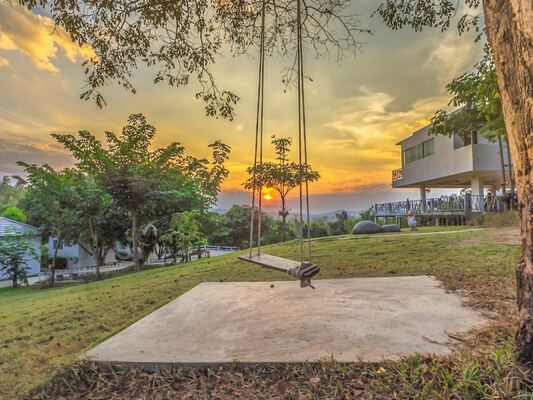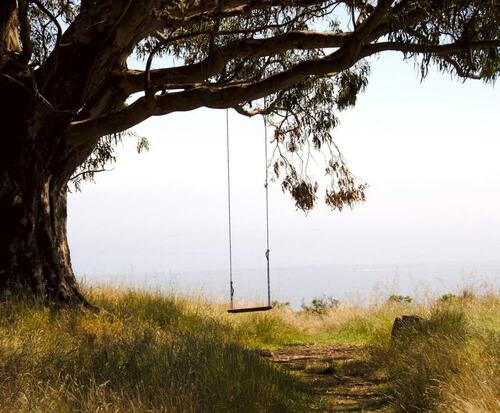Choosing Trees for Hanging Swings and Hammocks

Photo by Wibhas Onnom
Introduction
As the spring season approaches, you may be eager to enhance your outdoor space with a hammock or swing. These additions offer a perfect way to relax and enjoy the warm weather, providing comfortable seating that blends seamlessly with nature. However, choosing the right trees to support these structures is crucial for both safety and longevity.
In this guide, we'll explore how to select the best trees and locations for hanging swings and hammocks in your yard.
Choosing the Best Location for Your Swing/Hammock Trees

A Hammock Strung Between Two Trees - Photo by Elina Sazonova
Before selecting trees for your swing or hammock, it's essential to carefully consider their placement. The location you choose will impact not only the health of the trees but also the safety and enjoyment of your outdoor space.
Consider Space and Proximity
The trees you choose should be situated in an area that provides ample space away from outdoor furniture, structures, the street, and other trees. This prevents any potential collisions and ensures that the trees have room to grow without obstruction.
- Tip: Allow at least twelve feet of space in front of and behind the swing to prevent any accidents or damage to surrounding structures. Also, inspect the area for any obstructions, such as exposed tree roots, large rocks, or bumps that could pose a tripping hazard.
Evaluate the Ground Conditions
The ground beneath your swing or hammock is just as important as the trees themselves. Avoid placing swings on steep slopes or uneven terrain, as this increases the risk of falls and injuries.
- Ideal Surfaces: The ground should be relatively flat, and soft materials like grass, mulch, or wood chips are recommended for cushioning falls. Hard surfaces like gravel or concrete can cause serious injuries if someone falls off the swing or hammock.
The Top Species for Swing or Hammock Trees

A Man Relaxes in a Hammock - Photo by Andrea Piacquadio
Selecting the right species of tree is vital for ensuring that your swing or hammock is both secure and durable. Here are some of the best tree species to consider:
Oak Trees
Oak trees are a top choice for hanging swings and hammocks due to their incredible strength and longevity.
Key Characteristics:
- Height: Mature oaks can reach heights of 50 to 70 feet.
- Lifespan: These trees can live up to two hundred years, making them a long-term investment.
- Strength: Their elevated and sturdy branches are ideal for supporting the weight of swings and hammocks.
Care Tips: Oaks require regular watering, especially when young, and they thrive in various soil conditions. They are also relatively resistant to pests and diseases, making them a low-maintenance option for your yard.
Ash Trees
Ash trees are another excellent option, offering both strength and versatility in different climates.
Key Characteristics:
- Height: Depending on the species, ash trees can grow between 30 and 120 feet tall.
- Width: These trees can spread up to fifty feet wide, providing ample support for swings of all sizes.
Climate Adaptability: Ash trees are suitable for both cool and warm climates, making them a versatile choice for many regions.
Care Tips: Regular maintenance, including watering and pruning, will ensure that your ash tree remains healthy and strong enough to support a swing or hammock.
Beech Trees
Beech trees are known for their elegance and strength, making them an excellent choice for hanging swings and hammocks.
Key Characteristics:
- Height: Beech trees typically grow up to fifty feet tall.
- Form: These trees have a compact shape that allows for easy installation of swings and hammocks without crowding your landscape.
Soil Preference: Beech trees thrive in moist, well-drained soil and are best suited for open, less congested areas.
Care Tips: Regular watering is crucial for beech trees, especially in drier climates. Avoid planting them in urban areas where pollution levels might be higher.
Maple Trees
Maple trees are another great choice for swings and hammocks, and are known for their beauty and strength.
Key Characteristics:
- Height: Maples can grow anywhere from 30 to 100 feet tall, depending on the species.
- Strength: The branches of mature maple trees are strong and flexible, making them ideal for supporting swings and hammocks.
Aesthetic Appeal: In addition to their strength, maple trees are renowned for their vibrant fall colors, adding visual appeal to your landscape.
Care Tips: Maple trees prefer well-drained soil and require regular watering, especially in dry seasons. Pruning is essential to maintain strong branches that can support the weight of a swing or hammock.
Sycamore Trees
Sycamore trees are known for their massive size and durability, making them a reliable option for hanging swings and hammocks.
Key Characteristics:
- Height: Sycamores can grow up to one hundred feet tall, with a wide canopy that provides ample shade.
- Strength: The thick, sturdy branches of sycamores are perfect for supporting the weight of swings and hammocks.
Shade and Comfort: Sycamore trees offer extensive shade, making them an excellent choice for creating a cool, comfortable outdoor retreat.
Care Tips: Sycamores thrive in moist, well-drained soil and require regular watering. They are relatively low-maintenance but may need occasional pruning to remove dead or weak branches.
Our Final Thoughts on Choosing Trees for Your Swings and Hammocks

A Tree Swing Overlooks the Ocean - Photo by Luke Chui on Unsplash
Selecting the right trees for your swings and hammocks involves careful consideration of both their species and their placement. By following these guidelines, you can create a safe and enjoyable outdoor space that will last for years.
If you're uncertain about the best trees or locations for your swings, Arborist Now is here to help. We provide expert guidance on tree selection and placement, ensuring that your swing or hammock is both secure and aesthetically pleasing. Contact us today for professional assistance in the San Francisco Bay Area!
Originally posted on March 14, 2019.





